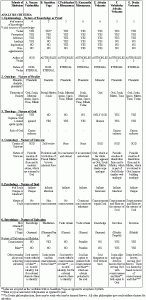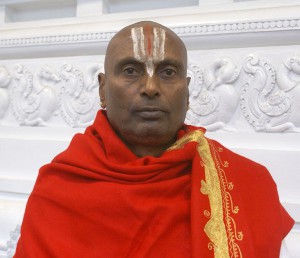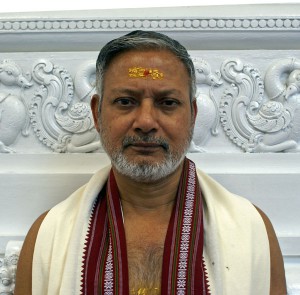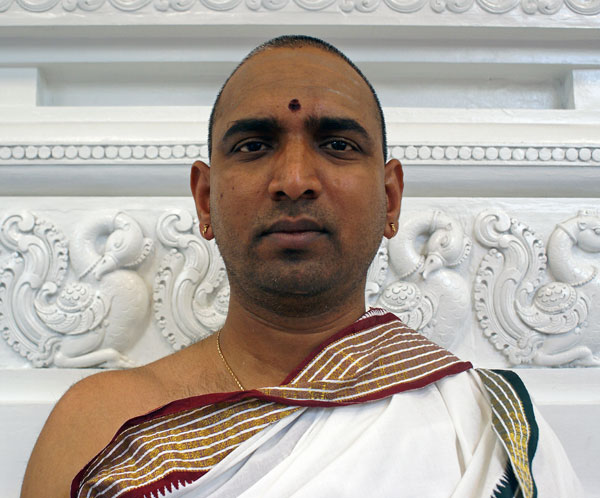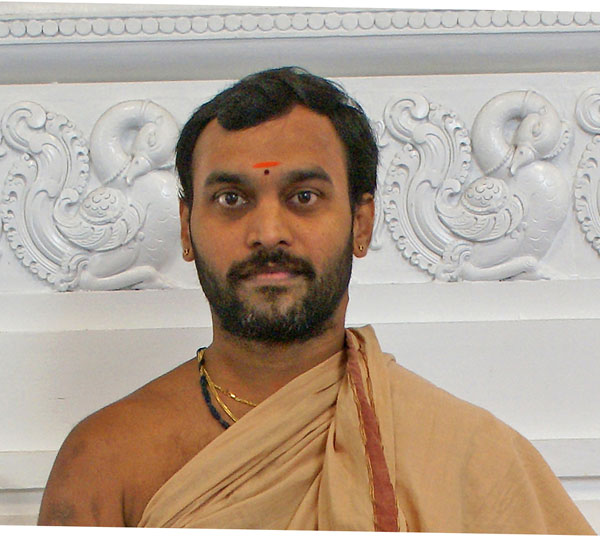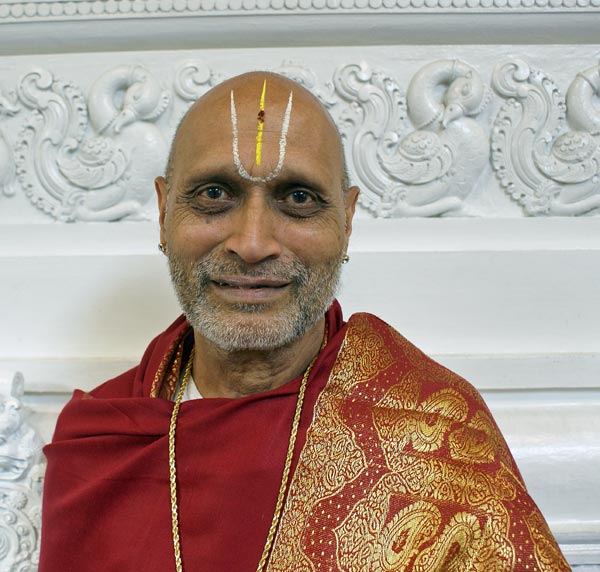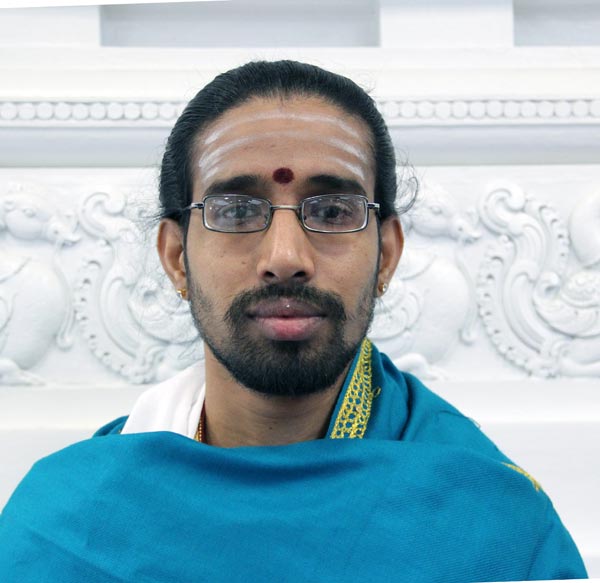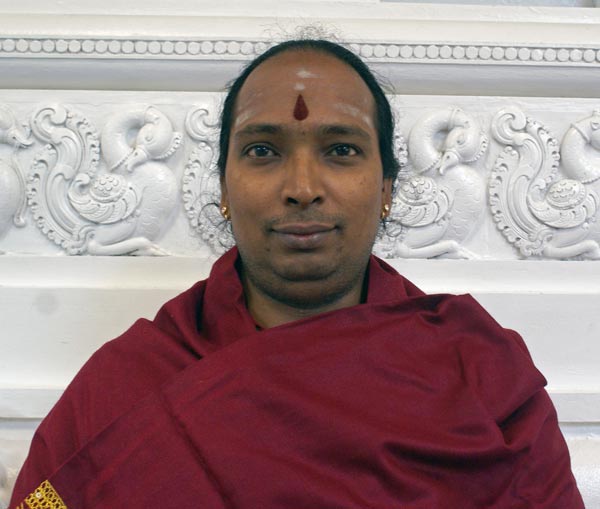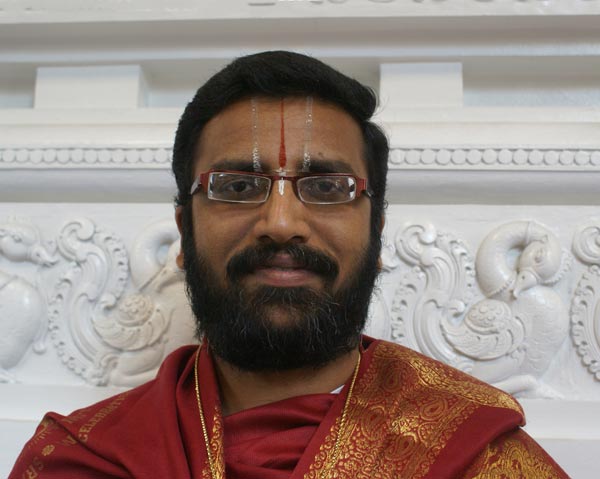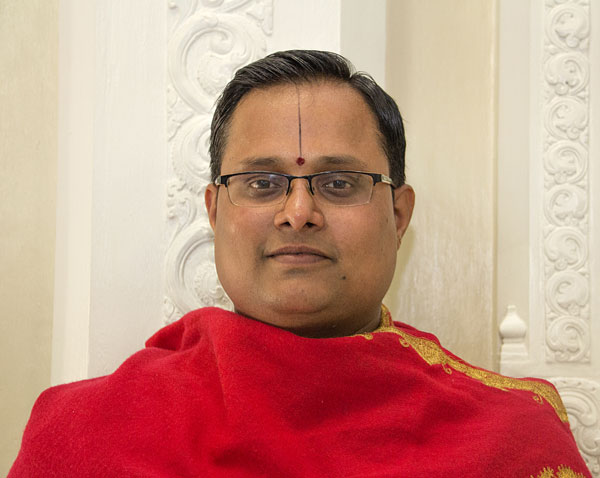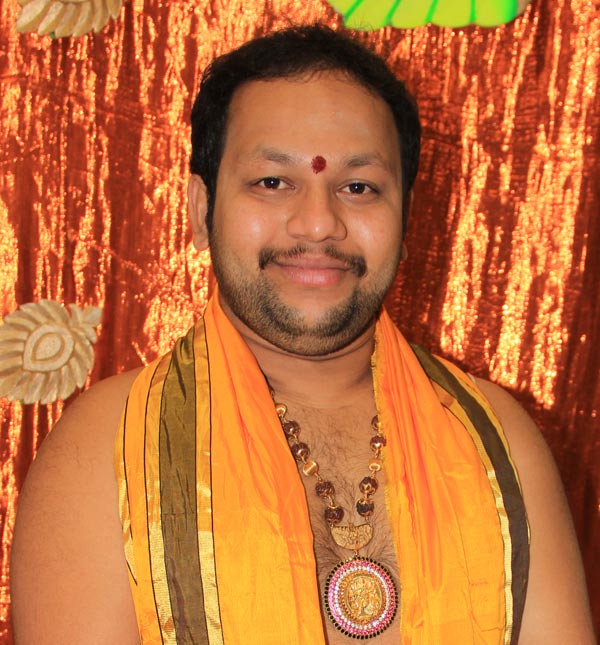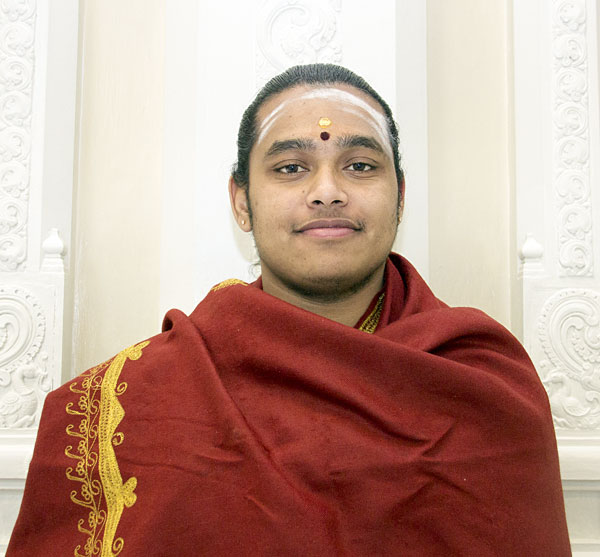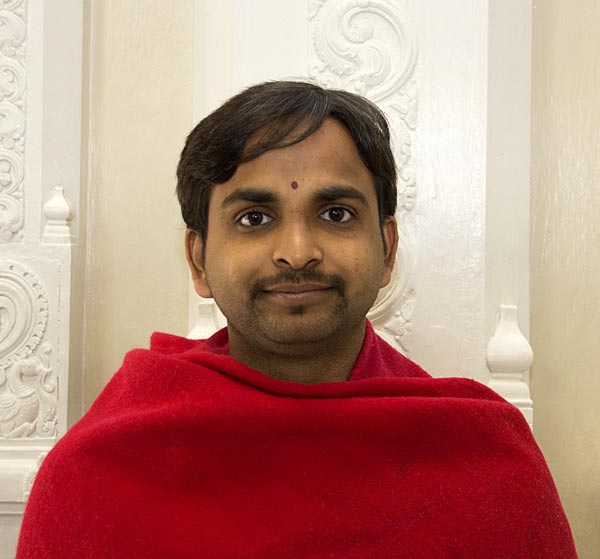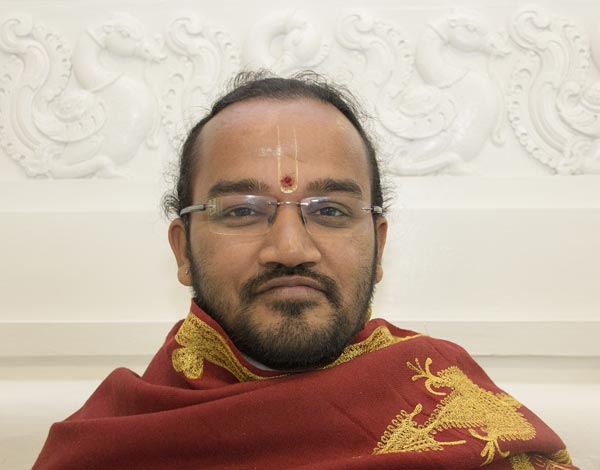Frequently Asked Questions About Hinduism
Have Comments or Questions? Click Here
SSVT presents a handful of questions related to Hinduism in the inauguration of this web page. We expect to update the material each month. We expect to add more questions and answers over the next several months, and build on the current questions as we hear from you. Please take the time to send any other questions you may have or to comment on anything you see on this web page by clicking on the appropriate link above. And if you would like monthly updates emailed to you, please register yourself by sending an email to ssvt@ssvt.org with your name and email address.
Position Statement: Hinduism covers a vast field, with many differing aspects of faith, varied philosophical systems, numerous paths to follow, and interesting varieties of ritual. There is a popular adage that if you ask the same question to a dozen learned Hindus, you may very well get twelve different answers and all of them would be true. The truth is one, but the wise talk of it in differing ways. Our answers and opinions are given according to our best understanding.
Summary Answer:
If a person has at least one Hindu parent or has chosen to adopt Hindu principles, and celebrates Hindu festivals, one may be considered a Hindu.
Detailed Answer:
There are many views in this regard.
One way of looking at it would suggest that a Hindu would observe at least some Hindu traditions as being part of a community. For example:
a. in lifecycle events like marriage ceremonies, death ceremonies etc;
b. in annual and seasonal festivals like Navraatri (or Dusherra), Diwaali (or Deepaavali), Krishna Janmaasthami, etc;
c. general community practices, like temple worship, etc.
Some higher levels of criteria may include such characteristics as having worthwhile objectives (Purushaartha) in life (see question 6, principle iii), believing in rebirth and evolution of the soul, and working towards ultimate realization.
From a strict traditional sense, to be a Hindu, one must either accept the Vedas & Vedaangas and/or Aagama & Tantra.
Summary Answer:
As long as one is praying at home, it is not necessary to go to a temple to remain a Hindu. One never stops being a Hindu.
While prayer at home is good, prayer at a temple is much better, because the temple is a specially consecrated place, and the idols are specially consecrated idols. The atmosphere and spiritual ambiance in a temple are more powerful and effective. Just as we do watch video pictures at home but, even so, go out occasionally to a theatre to see a film, we can pray daily at home, but need to visit a temple as often as we can.
Detailed Answer:
While there is no one single practice required for a Hindu, a Hindu would be expected to follow at least one of the many Hindu practices. Since temple worship is only one such practice, others may be substituted. And one never stops being a Hindu unless one chooses to relinquish Hinduism by actively converting to a non-Hindu faith.
However, there is a special importance for temple worship in modern living, particularly outside India. Since the temple is a consecrated place, the effectiveness of any practice in the temple is likely to be more powerful. The energy of this consecration is described often by temple visitors as a feeling of peace, bliss, happiness, etc. This, combined with the opportunity to interact with Hindu culture (which may not be available in ones neighborhood), becomes a double incentive for Hindus outside India to visit a temple regularly.
Summary Answer:
There is no traditional Hindu practice to convert others. However, historically Hinduism has spread to Southeast Asian countries like Cambodia and Indonesia in earlier centuries. Therefore, it would be reasonable to conclude that Hinduism does not actively seek to convert others, but there is room for anyone who wishes to become a Hindu.
Detailed Answer:
There is no conversion ceremony prescribed in the ancient tradition, although some modern leaders have invented some. Since anybody can claim to be a Hindu by adopting the principles and practices, there is no prescription in the sacred texts to proselytize others into the faith. Therefore, it would be reasonable to conclude that Hinduism does not actively seek to convert others, but there is room for anyone who wishes to become a Hindu. An observation made by some scholars suggests that by a proper study of Hinduism, a Hindu would become a better Hindu, a Muslim a better Muslim, a Christian a better Christian, a Jew a better Jew, and anyone a better human being.
The four stages of life recognized in Hinduism are:
- Life as a student – Brahmacharya
- Householder – Grihasta
- Reclusive and meditative seeker away from crowd – Vaanaprasta
- Renunciate (seeking Moksha) – Sanyaasa
[Please review worthwhile objectives of life in Question 6, 3rd principle of Hinduism]
Summary Answer:
Karma is the result of thoughts, words and deeds that stay with us birth after birth until we live out their consequences – as you sow, so you reap. The law of Karma can be considered as a universal law of cause and effect.
Detailed Answer:
Karma refers to both “act” (or action) as well as “results of thought, word and deed.” In the context of rebirth, Karma refers to the latter – the idea of cause and effect. Any thought, word or deed, that is not performed dispassionately with no interest in the results, yields Karma. Well-intentioned acts yield positive Karma (or Punya) and ill-intentioned acts yield negative Karma (Paapa). Such consequences have to be lived out.
Summary Answer:
Following are core beliefs/principles of Hinduism:
- Law of Karma and Reincarnation – Each one of us is more than the body. Our true self does not die with the body. Based on how we live our life, we are born and reborn taking different life forms until we evolve to the point of no birth, where we become one with God or stay close with God. (See question 5 for more details on Karma.)
- Freedom of Practice – One can be a Hindu by being a good person and following any type of worship practice that one finds appealing.
- Worthwhile Objectives of Life – Hinduism accepts that through life one can do many great things before one ultimately reaches God. Studying well, earning well, getting married, having children, being a good citizen and doing service to society, and then going beyond all of these and living life as a detached person ready to reach God, are all part of Hindu living and the path towards God.
- Divine Manifestation – Most Hindus believe that from time to time God will manifest on earth to help us keep to the right path and make us better. Raama and Krishna are examples of such forms of God coming to earth in human form.
Detailed Answer:
The following are considered core beliefs/principles of Hinduism:
- Law of Karma and Reincarnation – That the body is only the carrier of the consciousness, which in turn is the carrier of the soul is a fundamental assumption of Hinduism. This requires the consciousness to undergo birth after birth in different bodies, carrying with it the “Karma” of previous existence, until the consciousness evolves to the point of melting away with only the pure soulful awareness remaining.
- Freedom of Path with the Ultimate Goal of Realization – Individuals may choose whatever path is natural to them. All paths are ultimately supposed to lead to soulful awareness (living life as an observer) culminating in salvation. The four paths generally recognized as broad categories that encompass all paths are the paths of seeking knowledge (Jnyaana Yoga), doing self-less service (Karma Yoga), practicing physical and mental exercises (Raaja/Dhyaana Yoga) and the practice of devotion (Bhakti Yoga). Within these four, one can conceivably fit every activity that one performs in a day – the attitude towards the activity making all the difference. For those interested, the specific place of each practice differs in different philosophies of Hinduism.
For example:
A. In SAANKHYA-YOGA- Lowest Path is KARMA Yoga
- Then BHAKTI
- Then JNYAANA
- Highest is DHYAANA/RAAJA Yoga
B. In MIIMAAMSAA
- Lowest Path is DHYAANA/RAAJA Yoga
- Then BHAKTI
- Then JNYAANA
- Highest is KARMA Yoga
C. In SHANKARA-VEDAANTA
- Lowest is KARMA
- Then BHAKTI
- Then DHYAANA
- Then JNYAANA
D. In RAAMAANUJA-VEDAANTA
- Lowest Path is KARMA Yoga
- Then JNYAANA
- Then DHYAANA
- Then BHAKTI
- Then PRAPATTI
[Prapatti or Sharanaagati, although a new term here deserves special mention. It is specific to Raamaanuja Vedaanta and can be considered the highest level of Bhakti. It is complete unconditional surrender to the will of God. One flings oneself at the mercy (Dayaa) of the Deity and hopes for the gift of Moksha. Raamaanuja bases this doctrine on Shvetaashvatara Upanishad VI:18, Vaalmiki Raamaayana Yuddhakaanda 18:33 and Bhagavad Gita XVIII:66.]
E. In MADHVA-VEDAANTA
- Lowest is KARMA Yoga
- Then DHYAANA
- Then JNYAANA
- Then BHAKTI
In the path of devotion (BHAKTI), people have choice with respect to their worship practices as well as view of the divinity. God can be worshipped as formless (Unmanifest Brahman) or in any form (Roopa of deities) including idols, icons, statues, pictures (Bimbhas), Saligram (fossilized shell), Linga etc. in the firm belief God will present Himself in the form the devotee desires.
- Worthwhile Objectives of Living – Hinduism considers living with good conduct (Dharma), acquisition of wealth (Artha), enjoyment of love and pleasure (Kaama), and salvation (Moksha) as worthwhile objectives of living.
One can glean a hierarchy in these objectives coinciding with the 4 stages (Aashramas) of life recognized in Hinduism and the 4 sections of the Vedas as follows:
ARTHA = BRAHMACHAARYA = MANTRA (or Samhita)
KAAMA = GRIHASTHA = BRAAHMANA
DHARMA = VAANAPRASTHAA = ARANYAKA
MOKSHA = SANNYAASA = UPANISHAD - Avataar or Divine Incarnation – Vedaanta school of Hinduism, the most popular school of these times, accepts the idea that the Divinity can be born in a body from time to time to show the path and liberate others. The ten Avataars are well known, and among them the story of Raama in Raamayana and of Krishna in Mahaabhaaratha are even better known. An Avataar is a step taken by God out of His free will, but a human being’s rebirth is due to prior karma.
The other schools of Hinduism ignore the entire aspect of Avataars. Even among the Vedaanta schools of Hinduism there are some differences towards the view of the Avataar, but they all accept the idea, unlike the other schools. - Variety in the View of Divinity – Hinduism accommodates the idea of a single God and no God with the ambiguity of multiple gods (polytheism). The view of it depends on the school of Hindu philosophy. (See question 7 for more details on schools of Hinduism)
Vedaantic & Nyaaya-Vaisheshika View: There is one God or Divine Power that is part of everything that we see and beyond. Beings can be within bodies or exist in pure spirit (consciousness) form, and are all part of or within the control of the Ultimate.
Yoga-Saankhya and Mimaamsa Views: While non-theistic, they accept the existence of gods (Devas) – more appropriately thought of as spiritual beings with a portfolio in the governance of cause and effect in the universe – but reject the idea of one Supreme Being. The Samhita (Mantra) and Braahmana segments of the Vedas mention no Supreme Being, but praise many such spiritual beings, even though the Upanishads do speak of one Ultimate Divinity (Para-Brahman). - Damnation or What? – The Vedas speak of no damnation. In general, there is no idea of damnation in Hinduism, other than being dammed to be reborn until all Karmas are wiped out.
Dvaita-Vedaanta of Madhva is the lone dissenter among the Hindu systems in this regard. It does believe that certain souls go toward everlasting damnation. This doctrine of theirs is based on their interpretation of Bhagavad Gita (Ch XVI:20).
Summary Answer:
Nyaaya-Vaisheshika, Yoga-Saankhya, Mimaamsa and Vedaanta are the recognized schools of Hinduism. Within Vedaanta there are three major schools: Advaita Vedaanta of Shankaraacharya, Vishishta-advaita Vedaanta of Raamanujaacharya, Dvaita-Vedaanta of Madhvaachaarya. Within Mimaamsa, there are two schools of Prabhaakara and Kumaarila respectively. All schools of Hinduism accept the Vedas as the Ultimate Truth. Vedas and other holy texts are terse and hard to understand. So great sages and teachers of the past have interpreted the Vedas and other holy texts differently. Therefore there are many schools. While it is important to understand these schools to understand the different Hindu traditions, one can be a good Hindu without learning the details of these schools.
Detailed Answer:
Although most Hindus today have grown up in the Vedaantic school traditions, contemporary Hinduism recognizes the historical development of 7 schools of Hinduism, which started as 6 schools before Shankaraacharya.
The seven schools that formed between 400 CE and 1300 CE are:
A. Nyaaya-Vaisheshika
B. Saankhya-Yoga
C. Prabhaakara Mimaamsaa
D. Kumaarila Mimaamsaa
E. Shankara Vedaanta (Advaita)
F. Raamaanuja Vedaanta (Vishistha-advaita)
G. Madhva Vedaanta (Dvaita)
[It must be noted that while the three major schools of Vedaanta are recognized here, there are other minor schools as well with small following.]
Previous to that between 100 CE and 400 CE, the six schools were Nyaaya, Vaisheshika, Saankhya, Yoga, Mimaamsaa and Vedaanta. Later some of these paired off, while others developed different branches.
Essentially, a philosophy would be called a Hindu philosophy if they accepted the Vedas as the Ultimate Truth.
Even though all these schools accept the Vedas as the Ultimate Truth, there is a difference in their approach. For instance, any school will be called a school of Vedaanta only if the founder/s wrote a commentary on the Upanishads, Brahmasutras and the Bhagavad Gita (all three together called Prasthana-Trayi) to establish their point of view – the basis of differentiation and establishment of a separate school of Vedaanta. The other schools don’t require these commentaries. Mimaamsa schools give importance only to the Samhita and Braahmana sections of the Vedas and are focussed on rituals. Nyaaya-Vaisheshika emphasizes reasoning to understand God. Yoga-Saankhya schools emphasize direct experience through meditation.
Each school has its view of the place of knowledge (or personal evidence) in understanding God, the nature of reality, the idea of God, the nature of the universe, the nature of souls, and the idea of Moksha or salvation. Accordingly, each school has its preferred spiritual approach. The table at the end of this answer provides clear distinction based on these academic analysis criteria: Epistemology, Ontology, Theology, Cosmology, Psychology and Soteriology.
For the ease of the general reader, the following comments are noted with special emphasis on the Vedaanta schools which most Hindus follow:
A- Nyaaya and Vaisheshika believes in one Supreme God and considers reasoning (knowledge or Jnyaana) as the way of knowing God.
B- Yoga and Saankhya does not accept the idea of a Supreme God. In fact, this school alone accepts Vedas, not by faith like the other schools, but as the verifiable truth. The focus of this school is on direct experience.
C & D- The Mimaamsa schools, like the Saankhya-Yoga philosophy, do not accept the idea of a Supreme God. They do, however, accept that there are exalted and powerful, limited beings without gross bodies like ours. These beings can help to deliver well-being in the temporal world and the after cycles of birth and death, and salvation as well. It is debatable whether these exalted beings should be referred to as gods (indicating polytheism) or spirits. Mimaamsa philosophy considers the practice of various rituals (karmas) as very essential. They believe that the karmas (rituals) themselves yield the results, and there is no Supreme God or Ishvara dispensing the results.
E- Shankara Vedaanta, also called Advaita or Non-dualism thinks of the Supreme God as Para-Brahman and even in Bhakti mode feel free to visualize this Ultimate as any Ishtha Devata (favorite deity). The philosophy is that each one of us is the Ultimate God, but yet unrealized. It is Maayaa or illusion that makes one feel distinct from others. All is one – there is no two: is the Advaita philosophy. In South India, Advaitins are sometimes referred to as Smaartaas or non-Vaishnavas or Ayyars (sometimes written as Iyers, which is a Tamil corruption of “Arya”). Much mistakenly they are also referred to as Shaivites, which is a popular misnomer. Shankaraacharya was truly very broadminded. Even though he believed in the ultimate supremacy of reason and knowledge (Jnyaana), he attached great importance to devotion (Bhakti), temples and rituals. Accordingly, he incorporated the Shanmatas or six worship practices [of Ganapati, Kumaara or Subramanya, Surya (Sun), Shakti or Divine Mother, Siva and Vishnu] under the aegis of his Advaita-Brahmavaada and introduced the Smaarta-panchaayatana Pooja system for his followers.
F- Raamanuja Vedaanta called Vishishtha-advaita or Special Non-dualism think of Vishnu as the Supreme God according to the tradition of the founder. The philosophy considers each being’s soul as part of the body of the Ultimate God, which upon attaining salvation or Moksha stays eternally in heaven. Each soul is not considered the complete God in itself – as suggested by Advaita – and never really becomes part of God, even though philosophically they are considered part of the body of God. This confusion results from the followers of Raamaanuja trying to fuse the Puraanas with the philosophy of the Upanishads.
Dr. S. Radhakrishnan, the famous scholar and the second President of India, recognizes this inconsistency in the following terms: “Raamaanuja walks with olympian assurance like Milton through the halls of heaven.”
Vishistha-Advaitins are sometimes referred to as Sri-vaishnavas or Ayyangars (sometimes spelt Iyengars) in South India.
G- Madhva Vedaanta called Dvaita or Dualism, also thinks of Vishnu as the Supreme God. However, this school views each soul as distinct from God and is not considered part of the Supreme God. They believe that good souls ultimately come close to the Supreme God and reside in heaven. They accept that some bad souls would be damned forever in hell. Dvaitins are sometimes referred to as Maadhvaas or Vaishnavas.
It is important to understand these distinctions and realize that for most of us the real Ultimate Truth about the nature of divinity will never be individually experienced during our lifetime. Understanding these differences becomes a cohesive factor for all Hindus to come together, realizing that these differences are unverifiable for most people, practically irrelevant for daily living in contemporary society, with no difference in normative values of living. They do not upset or contradict the core values of Hinduism.
For those interested in the distinct differences of these schools, the following chart provides the details.
Summary Answer:
The most sacred of all Hindu texts are the Vedas. There are 4 Vedas. In addition, there are other texts that are meant to be read with the Vedas to fully understand them, which are called Veda-angas or limbs of the Vedas. Also, the text related to Aagama and Tantra are integral to religious practices of the temple. There are also other texts like the Puraanas, and the Itihaasas (Raamayana and Mahaabhaarata), and various philosophical texts, and Bhagavad Gita (which is a part of the Mahaabhaarata) and Brahma-Sutras, which are considered sacred texts.
Detailed Answer:
There are several sacred texts of Hinduism and there are different ways of categorizing them. The first category noted is non-controversial and is accepted as the most important and most sacred of Hindu texts. It is the other texts that have variations in their classifications.
CATEGORY 1: The 4 Vedas (Vedas literally mean Knowledge): Rig, Yajur, Saama and Atharva, including the 4 segments within each Vedas (Braahmana, Samhita, Aranyaka and Upanishad) which include well over 100 texts. These are considered the Shrutis — literally meaning what was heard, but really refers to the laws and nature of the universe and all existence, that can be felt by yogis in their highest level of awareness. These are considered the TIMELESS and UNCHANGING TRUTH, and therefore THE MOST SACRED OF ALL HINDU TEXTS.
All the other texts are considered Smriti – literally meaning what was remembered, and therefore have a lower standing than the Vedas, the timeless and natural truths of existence.
CATEGORY 2: The other holy texts of Hinduism
The 6 Veda-angas (limbs of the Vedas) include the following segments with many associated texts in each sub-category:
- Sheeksha – science of phonetics
- Kalpa – practical manuals for personal and temple practices
- Vyaakarana -grammar
- Nirukta – etymology
- Chandas – prosody
- Jyotisha – astronomy and astrology
In addition, Aagama and Tantra texts need to be noted here.The practice of the Vedic religion requires the knowledge of these ‘limbs’ of the Vedas. But temple worship practices require Aagamas and Tantra as well.
Without knowledge of grammar and etymology one cannot understand the interpretation of the texts. Without the science of phonetics or prosody, once cannot chant properly. Without understanding the principles of astronomy and astrology, one cannot apply the elements of the practical manuals, which deal with the elemental forces. And the Aagamas and Tantra guide the methods and flow of temple religious practices.
Within the KALPA SUTRAS noted above are:
- Grihya Sutras [Veda based domestic rites]
- Shrauta Sutras [Veda based public rites]
- Dharma Shaastras – Codes of conduct for living, like Manusmriti, etc. The thoughts presented in a number of these texts, especially related to the place of women, castes, etc. may be realted to past ages, and may be understood from a historical perspective.
Text of Aagamas and Tantras, connected with temple religion in Hinduism, include Shaiva, Vaishnava, and Shaakta. Among the Vaishnavas there are two Aagamic rites, i.e. Vaikhaanasa and Paancharaatra.
The Itihaasa-Puraanas have a special place in Hinduism.
- Raamaayana, Mahaabhaarata [including the Bhagavad Gita]
- The 18 Mahaa (Big) Puraanas, 18 Upa (lesser) Puraanas,
The Brahma-Sutras, along with the Bhagavad Gita and the Upanishads are called Prasthaana-Trayi, of 3 views or angles (literally departure points), and have a special place among Hindu texts.
The texts related to the various schools of Hindu philosophy are also considered part of the holy texts. In addtition to the texts of the regular school of Hindu philosophy (see question 7), two other groups of texts worth mentioning here are: the Tamil compositions of the 63 Shaiva Adiyaars and the Naalaayira (meaning 4,000)-Prabandham of the 12 Vaishnava Aalvaars [also known as the Tamil Vedas].
Other fields of knowledge are also considered part of the texts of Hinduism. These include the science of life and medicine (Ayurveda), science of martial arts (Dhanurveda), fine arts (Gaandharva-veda), the art of politics and governance (Arthashastra) and the science of building and architecture (sometimes called Sthaapatya-veda).
Since Hinduism views every moment as spiritual and life itself as a spiritual journey, there is nothing that cannot be considered sacred. In the context of the sacred texts, the Vedas have a very special place, being considered the TIMELESS TRUTH.
Summary Answer:
Hinduism is not the name given to their religion by the Hindus. It is thought the Persian pronunciation of Sindhu, the river, as Hindu, and calling the people of that region Hindus made their religion Hinduism for the westerners. Hindus call it Sanaatana Dharma or the Eternal Truth.
Detailed Answer:
Hinduism is a name that was given to the religion practiced by those ancient people who lived in the banks of the river Sindhu, later called Indus, and pronounced Hindu by the Persians. And that gave the name Hindustaan or land of the Hindus. Hindus themselves do not attribute a name to their religion – especially unlike other religions there is no founder for this faith. It could be called the VAIDDIKA DHARMA or Vedic Religion as based on the Vedas. Sometimes it is referred to as the Eternal Truth or SANAATANA DHARMA.
But what is in a name as long as it serves recognition? So, indeed the practitioners of this faith are Hindus and the faith is called Hinduism.
Summary Answer:
Hinduism is both a religion and way of life, since religion involves beliefs and way of life involves our conduct in living.
Detailed Answer:
Hinduism is both a religion and a way of life. Obviously there is some faith involved until one has the experience of the Ultimate. And there are prescriptions to follow, if one chooses to follow them. So, indeed it is a religion in whatever way one practices it. And, it is indeed a way of life, since every act one does, every moment of ones life, is considered part of the spiritual evolution. In other words both BELIEF (religion) and BEHAVIOR (way of life) are important and reinforce each other.
Summary Answer:
In its original form it was perhaps a functional arrangement within society. Society as a whole needs several types of work to be completed for organized living: the priests and advisors, the ruler and soldiers, businessman and workers. Everybody being the creation of God and having their own place of importance in society, all should be respected equally.
Detailed Answer:
Caste can become a controversial question. In its original form it was perhaps a functional arrangement within society. Society as a whole needs several types of work to be completed for organized living.
From a Vedic perspective, the Purusha Sookta (a hymn from the Vedas) simply notes that everything that we see and beyond is the Ultimate Purusha or God, and each facet of creation is seen as part of God. In that context different body parts of God are described as being the different castes. (While some interpretations of the text actually ascribe the various castes as having emerged from the body parts, the Sanskrit text does not clearly deliver that meaning.)
Such a view of the Vedas leaves open the issue of whether castes are determined by birth (when profession is learned from father to son) or by profession in living (ability to change circumstances with a broader opportunity for education). However, there are many stories that indicate that castes should be viewed based on role in society and not by birth. Vishvaamitra, the great sage, while born in a Kshatriya family (having been a king before), was recognized as a Brahma Rishi. Vaalmiki, the revered saint, was a hunter before authoring Raamaayana.
If the Lord is viewed as the entire world, the intellectuals, opinion makers and teachers of the society constitute the Brahmana. Those who protect the society are the Kshatriyas. Those who control and move the economy are the Vyshyas. And finally those who support the entire society are considered the Shudras. And none of these roles are defined by birth.
Summary Answer:
Hinduism regards all creation as divine. From a spiritual perspective there is a no higher or lower place awarded to women, although in the role of a mother who gives birth, a woman is compared to the Divine Mother (Shakti) who has given birth to all creation.
Detailed Answer:
Hinduism regards all creation as divine. From a spiritual perspective there is a no higher or lower place awarded to women. There is evidence of women being given the Yagnyopavita (sacred thread) and being allowed to practice spiritual rituals.
However, there is also recognition that a woman is essentially different from a man in her ability to give birth (to a child). In this regard, a woman has been compared with the Divine Mother who has given birth to the entire universe.
It is with this symbolism of the Mother Divine that often Poojas are done to women during certain festival seasons.
From this respected place of women, the invasions of foreigners into India, their tendency to molest and kidnap women, and the consequent protective tendencies of the Hindus appears to have forced women indoor and in a less dominant role. All of this is slowly reversing, and the natural resilience probably ensured that India was one of the earliest countries in modern times to have had a woman elected as the Prime Minister/Premier of the country.
Summary Answer:
Swamijis are people who have renounced life and seek to reach God. The saffron colored robes they wear are the color of fire, symbolizing fire that has consumed and purified everything. Since they have to give up everything in life, shaving off the head symbolizes giving up one more element indicative of ego.
Detailed Answer:
Traditionally Swamijis are renunciates (Sannyaasis) – the fourth stage of life noted in question 4. Such persons do not acquire or keep wealth, eat only the food offered as Bhiksha (donation of food), and are either supposed to be Realized Souls or on the path of actively pursuing Realization by shedding all attachments. Sannyaasis maintain no contact with their birth families since in their attitude they should see no difference between anyone (the whole world is their family) and are typically living in forests or retreats away from the average humanity. Living with the idea that everything other than the goal of Salvation is “TUCCHA” or NOT WORTHY, they would not see any association with anything – becoming “Udaaseena” or dis-interested.
While the roots of renunciation is a part of Hindu tradition, Buddhism appears to have had some influence on its later manifestation.
In this tradition of giving up everything worldly, it is common to shave off ones hair (a decoration is considered a mark of ego) – probably a Buddhist influence. It is probable that the Buddhist tradition created monastic living in and near urban centers with the goal of spreading the teachings, and was probably borrowed by the newer traditions of Sannyaasis of the 19th and 20th century.
Followers of the Mimaamsa school of Hindu philosophy are the only school of Hinduism who oppose monasticism of any kind. They consider such institutions as not consistent with the Vedas, since in their view anybody who cannot perform fire-sacrifice cannot be a follower of Dharma (or required conduct). (Sannyaasis of Monastic orders give up fire use as part of their initiation.)
From the viewpoint of the stages of life (see question 4), renunciation is a natural process in the last stage. Possibly from the Vedic Hinduism perspective, it is more internal and personal, and the type of clothing one wears, where one lives and how they wear the hair, and whether they use fire, etc. may actually be completely irrelevant.
A more innovative and modern view of Swamijis expressed by one Swamiji, is not that of a renunciate, but a scholar of Vedaanta. This is not the traditional or general view of one who wears saffron robes, although there may have been spiritual/religious teachers who are sometimes referred to as Swamis out of respect, who may be normal householders.
Given the age of Hinduism, Swamijis are probably the more recent creations in the last few millennia, although non-monastic Sannyaasis go back to more ancient times.
Summary Answer:
Ritual is an essential part of human life, whether it is in the playing field or the protocol of the White House. Every religion has its rituals and so does Hinduism. And rituals create a mental discipline that is supposed to lead to spiritual elevation.
Detailed Answer:
Rituals have a very special place in Hinduism from two perspectives:
First, the Mimaamsa school of Hinduism which appears to have mastered the art of managing cause and effect, had as part of its core various rituals that would provide temporal and spiritual upliftment and relief.
Second, from a more broad-based view of belief-based Hinduism, viewing the living process as an evolutionary process, rituals create the ability to live life as an observer – doing for the sake of doing. Modern day psychologists recommend rituals in life as a way of managing stress.
Summary Answer:
The scared thread or Yagnyopavita is for purifying ones thoughts, words and deeds in the course of living. Physically, it consists of three strands of thread, connected with a knot. The sacred thread is invested with the Upanayanam ceremony. After the investment, Sandhya-Vandanam is required three times every day – at sunrise, midday and sunset.
Detailed Answer:
This is a Vedic Practice of controlling ones thoughts, words and deeds represented by the three strands of the Yagnyopavita.
From a yogic perspective, the process of controlling thoughts, words and deeds can be thought of in terms of the flow of Praana or energy in the body through the 3 principal energy channels called Sushumna, Ida and Pingala. The knot in the three strands is supposed to symbolize the point of control or the Aagnya Chakra where the three energy channels meet.
Summary Answer:
It is just a Hindu symbolism to remind us to use our head and be in control.
Detailed Answer:
This is purely in Aagamic Hinduism. Vedic Hinduism has no such regulations. One view is that it is the reminder that the mind (in the Aagnyaa Chakra) is the seat of power and control and one should strive to move higher through the mind.
However there are other views as well. Different colors may have some symbolic significance and the way it is worn may signify castes and sects as well.
Summary Answer:
Like all other professions, priests undergo rigorous training – traditional practice is for about 12 years from a very young age. They learn to chant the Vedas, learn Sanskrit and various other sacred texts and also learn the practice of various ceremonies.
Detailed Answer:
Like any other specialized function, the work of a priest demands certain qualities like aptitude, including appropriate family background, many years of training, and a high level of commitment and faith. Selected youngsters go through a rigorous course of training for twelve years, usually under a dedicated teacher or in appropriate schools in India. The study includes a minimum knowledge of Sanskrit, ability to chant the Vedas, familiarity with Aagama Shaastras, temple worship methods, and temple ritual, as also a capacity to conduct poojas, samskaaras and religious programs in devotees’ homes. Very often, a spell of work as an assistant to an established priest in a temple works out well as an initial apprenticeship.
Generally 12 years is considered an important period in the training of priests for a very special reason. The priest works as the medium to convey the needs of the beneficiary (Yajamaana). That is done in the form of energy or Praana. To have the ability to do that, practice of Sandhya Vandana thrice a day is required. Twelve years of practice of Sandhya Vandana is supposed to give every priest the ability to move energy, although some may attain it earlier.
At present, we know of no facilities in the USA for training Hindu priests.
Hindu priests are allowed to marry and live life as householders.
Answer:
Vedic Sanskrit is pre-Paaninian while classical Sanskrit [every other Sanskrit composition except the Vedas] is post-Paaninian. The Ashthadhyaayi of Paanini standardized Sanskrit grammar getting rid of many archaic Vedic forms.
Paanini is accepted by scholars of Sanskrit as the greatest, and perhaps, the first Grammarian who exhaustively codified and standardized the Sanskrit language and grammar.
Summary Answer:
Usually, Hindus greet each other with affection and reverence, reflected by a smile on the face and the “Namaste” gesture of bringing the two palms together in front of their chest. It literally means “Salutation to you” and is a recognition of divinity in the other. The other words from different Indian languages mean the same.
Usually, Hindus greet each other with affection and reverence, reflected by a smile on the face and the “Namaste” gesture of bringing the two palms together in front of their chest. Many dancers know that the face and the fingers of the hands are great vehicles for demonstrating the various emotions.
Detailed Answer:
“Namaste” in Sanskrit means “Salutation to you.” The cognate words in other Indian languages also signify the same thing. It is true that this gesture, word, salutation or prostration is primarily employed during worship to a God. But as Hindus believe in the divinity of all creation, and a spark of divinity is inherent in every human being, this gesture towards others emphasizes the inherently divine nature of all human beings also.
Summary Answer:
OM, or AUM, is the one-syllable word called Pranava, that represents God in Hinduism.
The regular practice of chanting OM enhances and improves one’s breathing, strengthens one physically, mentally and spiritually, and even helps youngsters to sing, or swim or play games better.
Detailed Answer:
OM, or AUM, is the one-syllable word called Pranava, that has great significance in Hinduism. The Vedas specifically say that this one syllable word is synonymous with the Ultimate TRUTH called BRAHMAN.
AUM is also regarded as a combination of the three sounds, viz., the two vowel sounds of A, and U, and the consonant, M. One view is that the three alphabets are said to represent Vishnu, Siva and Brahmaa. There is a saying:
Akaaro Vishnur Uthishta Ukaarasthu Maheswarah:
Makaarasthu Brahma Pranavasthi thryatmakah:
meaning
the letter “A” stands for Vishnu
the letter “U” stands for Maheswara
the letter “M” stands for Brahma.
Thus in the Pranava (AUM) all three lords are present.
[Curently the above sloka is present under the Jnyaana Upadesham at SSVT]
Another observation made by scholars has an implication of AUM representing everything from beginning to end – again the Ultimate Divinity – as represented by the first letter of the Sanskrit alphabet A and the last among the consonants M. [The other alphabets after M in Sanskrit are considered compounded alphabets.]
Another view considers “AUM” as the weak [Vriddhi] form, representing the Samsaaric state where:
A = Brahman (Ultimate)
U = Atman (Soul)
M = Maayaa (illusion) – Jagat (perceived world) – Prakriti (manifested form)
whereas “OM” is considered the strong [Guna] form representing the Moksha state where:
O = Brahman=Atman [based on Tat Tvam Asi (That is You referring to Self),
Aham Brahmaasmi (I am the Ultimate) etc.]
M = Maayaa (illusion) – Jagat (perceived world) – Prakriti (manifested form)
There are other Upanishads which have tried to explain the Pranavam as well. Some of them are:
In Taittiriya Upanishad:
OM Iti Brahman, OM Iteedam Sarvam
i.e. OM is Brahman, OM is this all.
In Katha Upanishad:
That word which all the Vedas declare
Which all austerities proclaim
Which men desire when they lead the life of religious studies
The word, I tell you briefly
IT IS OM
In Mandukyopanishad:
OM – this syllable is this whole world
Its explanation is thus –
The past, present and the future
all this is only the syllable AUM
and whatever else there is that transcends the threefold time
that too is the only syllable AUM
As a symbol and syllable representing the Ultimate, and also its triune manifestation as the Holy Trinity, the sound OM or AUM is given immense importance in religious practice. It is chanted by itself, and also before, and after, every other chant.
The regular practice of chanting OM, particularly vibrating it in various part of the energy flow system in the body recognized by Yoga, is supposed to enhance one physically, mentally and spiritually.
Summary Answer:
Hinduism views temporal living as a journey of the soul towards salvation. Living life in all its dimensions, at work and at home, is considered as satisfying the cravings of the consciousness. This is the process of living out and exhausting the karmas – a necessary process to attain salvation. Therefore every moment in living can be considered spiritual.
Accordingly, an evolved soul from the Hindu perspective would be expected to participate in every aspect of living, but with the attitude of an observer or witness, and therefore being above suffering and generation of new karmas. In this state, the living is not only spiritual, but the person lives every moment with the awareness of spirituality.
Detailed Answer:
While every moment in life is indeed spiritual in the sense that one is coming (hopefully) closer towards the ultimate goal of salvation (Moksha), most people may not be aware of it. Those who are aware live as observers or witnesses of life fully living every moment of it. Thus it is true that Hinduism tries to elevate every moment into a spiritual moment and every thought, word and deed as an offering to God (in the theistic approach) or as something natural with no interest in its outcome (in the non-theistic approach). The Bhagavad Geeta, for example, contains a specific exhortation to that effect by Lord Krishna to Arjuna.
Attitude of Living Makes a Difference:
It is indeed possible gradually to develop such an attitude to life and even to all our apparently trivial actions. There is a story that a man was walking along the streets near London about two centuries ago. He saw several bricklayers at work and he asked three of them, one after another, the same set of questions.
The first bricklayer said that he was a miserable bricklayer, his work was drudgery, he got only a tuppence as his wage, and it was just not enough for him and his family. The second worker said he had been trained for his job of mason, that he was building a wall, that his job was OK, and the two pennies he earned just met his needs.
The third worker said, “For the greater glory of the Lord, I am involved in the building of St Paul’s Cathedral, the work is my life’s passion, I enjoy it and I earn all of two pennies which meets my family’s needs and leaves some money which I share with the poor.” He considered himself blessed in every way.
All three were in the same situation but their attitudes were different. Hinduism tries to foster the last attitude whereby every work becomes God’s work. When a person can work and earn a living with that attitude, the work becomes sanctified as Karma Yoga, and fulfils the noble objective of earning and spending wealth wisely (called Artha, one of the Purushaarthas). Such selfless action cleanses the mind and hastens the path to self-realisation or liberation.
Importance of Marriage And Its Significance:
While marriage can be thought of as another process in living, leading to Moksha, there is more attributed to it. Between Hindu philosophies, Puraanas and worship practices (with assumptions of hierarchies of divinities), there are many suggestions that the union of a man and woman should be considered as epitomizing the Whole (God). Different schools lay it differently. One school may consider it as epitomizing the coming together of the unmanifest potential energy (man) coming together with the manifest kinetic energy (woman) to form the Whole (the Siva-Shakti idea!). Another school draws the parallel of a dutiful wife to be the individual being and the husband being served as the ultimate God (parallel of the Jiva-Atma [embodied soul] and the Paramaatma[Ultimate Soul or God]!).
And every school of Hinduism accepts that the Purushaartha called Kaama, or love and family life, is fostered by the noble sacrament of marriage. The marriage vows and mantras sanctify the union of man and woman from a mere physical act of passion to a lofty impulse that continues the human race. In the Bhagavad Geeta, the Lord says that He is the Kaama or desire that is in accordance with Dharma.
The householder living a righteous life, according to the tenets of Dharma, becomes the lynchpin of the family, of society and of mankind as a whole. Specifically, the married householder or Grihasta has the duty also to fulfil the needs of the student (Brahmacharin) and the mendicant (Sannyaasi) by giving them food or Bhiksha.
Even in a modern context, a career need not become a rat-race, but can be transformed into a deliberate and noble offering to the Lord. Likewise, the marriage ceremony becomes a sacrament leading to a life-long journey together along the path of dharma; it is therefore that a Hindu wife is called a Sahadharmini in Sanskrit, who enables, guides and follows the husband in walking the path of dharma together.
Usually, during a Hindu South Indian wedding ceremony, the couple are blessed with a benediction which says “May you both live worthwhile lives like Raama and Sita, like Siva and Paarvati, Agasthya and Lopamudra, Vasishtha and Arundhati, etc.” The Gods of the Hindu pantheon lead married lives and great sages have also lived worthwhile lives in holy wedlock. A Sanskrit verse says that without Shakti, the female principle, the male Siva is powerless. The idea is that a well-lived married life is a spiritual endeavor and a positive step towards bliss here, and to liberation in the hereafter.
Watch out for this answer! It will be posted soon.
Summary Answer:
Karma from previous birth creates suffering. If one prays (or does other spiritual practices) regularly over many years, divine grace may eliminate all such Karma and the consequent suffering. Another way of saying the same thing may be that awareness of the nature of existence is enhanced and one becomes a mere observer of events in life, living life effortlessly without any sense of suffering.
Detailed Answer:
The theistic traditions of Hinduism say that suffering comes from previous Karma which is born out of spiritual ignorance (Avidya). God does not interfere in the workings of Karma, unless specifically asked by the devotee.
The non-theistic traditions reject the existence of a Supreme God for this precise reason, although the law of Karma is accepted. Sufferings end by spiritual elevation leading to Moksha.
In general most traditions recognize that by realizing that one is not the body and viewing the temporal world as only a point of observation, one naturally remains unaffected by worldly suffering. Suffering comes from identifying oneself with the gross being.
Summary Answer:
Shoes are not clean since they go everywhere. Since a temple is a clean place with pure energies, we leave unclean things outside.
Detailed Answer:
There are a few views offered on this subject:
- Shoes go everywhere and can collect unwanted energies. To keep them out of the temple shoes are left outside.
- Second, generally temple practices encourage minimum amount of covering, subject to what would be considered decent in the respective social setting.
This may be related to the ability for energy interchange – the temple being a highly energized place. In that context, among various parts of the body, the soles of the feet are considered points of significant interchange of energy. This way when one walks in the temple bare foot, the interchange of energy gives the bliss and high of being in the temple.
While the two views noted above are the popular reasons for not wearing footwear inside the temple, there are some additional observations worth noting with regard to footwear use in temples.
There are certain temples in northern India that allow wooden Paadukas to be worn during winter months. In fact, the temple itself provides the wooden Paadukas for a small fee, essentially ensuring that the footwear that goes everywhere outside the temple does not come into the temple. In Udupi Krishna temple, the eight Acharyas only [not devotees] are allowed wooden Paadukas anywhere in the temple premises except in the shrine area itself.
Summary Answer:
Cremation is hygienic and symbolizes desire to go beyond birth.
Detailed Answer:
Hindu custom of cremation is probably related to:
- No further desire for rebirth (reincarnation)
- Disinfecting – more hygienic disposal.
It is worth noting that Sannyaasis are not cremated, but rather buried, since in the process of acquiring Sannyaasa the Sannyaasi has already performed “Aatmashraaddha” and burned an effigy of his own body. Hence a Sannyaasi is already considered having gone beyond rebirth.
Summary Answer:
Many Hindu philosophies are monotheistic. However there is flexibility to think of that God in the form of any Devata. While there are 330 million Devataas and many other types of spiritual beings mentioned in the holy texts, there is a definite hierarchy of these beings that is recognized within the Whole of That One God.
Detailed Answer:
Whether Hinduism is monotheistic or non-theistic (or polytheistic) depends on the school of Hindu philosophy.
Nyaaya-Vaisheshika, and Vedaanta Schools – Vedaanta school is the dominant group of these times – are monotheistic.
Yoga-Saamkhya and Mimaamsa schools are non-theistic (with the potential to interpret as polytheistic at the same time). While not accepting a Supreme Power, they do accept many spirits with limited powers (called Devataas) which are sometimes called gods in common parlance. If they are considered gods, the idea becomes polytheistic. It is debatable whether these Devatas should be interpreted as gods or just as divine beings whose form is in spirit.
There are supposed to be 330 million Devatas and other spiritual beings mentioned in the holy texts. There is a definite view of hierarchy of these Devatas – within the context of One God for the Monotheistic schools and within the context of No God in the non-theistic schools.
The editors of this document are not knowledgeable about the hierarchies of all the schools. Following are the examples of hierarchies that are known. [Any reader who wishes to supplement with their thoughts is welcome. We will consider posting it in a later update.]
In the Shaiva Agaama worship practices (under Advaita Vedaanta) Surya represents Godhead and is thought as Siva or ParaSiva or Sadaasiva. The Shakti part of that Siva creates all of the Universe and the spirits in the Universe. Brahma, Vishnu and Rudrasiva are under Shakti. Below them are all the Devas.
An almost identical hierarchical view exists within the Tantra worship practices.
In Vaishnava Aagamas, the hierarchy begins with Vishnu as the Ultimate and with Lakshmi in a role similar to Shakti in Shaiva Aagama. Following are the details of the hierarchy as per Madhva Vedaanta worship practices: Vishnu [Possesses Independence, Plenitude & Freedom from Grief] is the Ultimate, with Lakshmi [Possesses Plenitude & Freedom from Grief] as his consort with some of his abilities. Then come Brahma and Vaayu who possess freedom from grief. Thereafter are Garuda, Rudra and Aadishesha. Then come all the devatas under Brihaspati, Indra and Varuna.
Popular Hinduism believes in Henotheism – the practice of temporarily elevating one Devata to the level of Godhood by praise (Stuti).
In Vedic Hinduism, the Rig Vedic deities like Indra, Varuna, Mitra, Niririti, etc. are recognized. Indra and Varuna at different times appear to have been considered as the head of all deities. These may be considered comparable to the ancient Greek and Egyptian deities of those times, probably viewed as polytheism, or non-theistic as viewed by Mimaamsaa practices of the later age. In later Mimaamsaa practices, while essentially non-theistic, most of the Rig Vedic deities seem to have retained their places, clearly viewing them as helpful, but limited celestial spirits. The hierarchy of these deities in the Mimaamsaa practices were similar to Vedic Hinduism practices.
Summary Answer:
There are no authorities to decide what is right or wrong. The Vedas are considered the Supreme Truth.
Detailed Answer:
Literally there are no authorities that dictate what Hinduism should believe in.
The highest authority is considered the Vedas and its interpretation by various schools of thoughts give rise to various Hindu philosophies. The Vedaanta schools (its founders) have commentaries on the Upanishads, Brahma Sutras and the Bhagavad Gita which are supposed to be further elucidation of the message of the Vedas.
And it is up to each individual Hindu to decide what school of thought one wishes to accept or how one wishes to interpret the Vedas.
However, since many Hindus may not have the expertise to interpret the Vedas or may not have a high level of realization (or awareness) themselves or may not be familiar with the tradition of their families, they may consider the words of a wise person to guide them, and apply the teachings to their lives with appropriate application of common sense and living within the law of the land.
Summary Answer:
At first blush, it is a prayer to the Devas that bestow Mantric power that is performed three times everyday by those who wear the sacred thread. However it is more than that. It is a practice that seeks identification of the self with the Ultimate in gradual progression.
Detailed Answer:
At first blush, it is an obeisance to Gaayatri and Savitr, the devas of Mantric power, done three times everyday. However it is more than that.
The Sandhya worship each time is in two parts.
The core or essence of the first part (Poorva Bhaaga) is the mantra emphasizing the identity of the self with the Supreme Consciousness. The Mantra is “BRAHMA EVAAHAM ASMI.” This echoes the Mahaa Vaakya or supreme pronouncement of the Upanishad which even realized souls strive to assimilate. This ultimate step and final goal is brought to the attention of the Brahmachaari boy right at the very commencement of his long journey.
Likewise for the second part (Uttara Bhaaga), the Gaayatri mantra and Japa is the very core. This Japa becomes the means to realize gradually and reach the ultimate goal set out clearly in the first half.
From a Yoga perspective it can be viewed:
- As an offering to various constituencies of the spiritual domain for temporal and spiritual well-being – through Arghya and Tarpanam offering;
- As cleansing and empowering by various rituals like sprinkling of water, mental cleansing, doing Praanayama (Yoga technique) and invocation of Rishis, Chandas and the deities Gaayatri, Saavitri and Saraswati.
- It is Dhyaana or Meditation while doing Gaayatri Japa, through which the Ultimate experience of Samaadhi is attained. Invocation of various spirits before beginning the Mantra Japa can be viewed as empowering meditation.
The dawn, mid-day and dusk worship is focused on The Lord Surya, but as the symbol of Brahman. Gayathri is the meter as well as the Devata. In the spiritual progression initially it is a ritual to bring mental discipline. As the person advances the focus is more and more towards identifying with Devatas and then ultimately Brahman.
Summary Answer:
The Hindu concept of space is infinite. Depending on the school of Hindu thought, it could be considered objective reality, or expression of matter, or as illusion. From a Vedic Hinduism standpoint, only three worlds are described. In (later) Classical Hinduism, the 14 world concept is described from the Puraanas or from the Yoga texts. The reference to millions of worlds can be considered a poetic expression or as suggested by Dr. Karan Singh it could refer to the millions of galaxies.
Detailed Answer:
The Hindu concept of Space is infinite. Different systems of Hindu thought consider “Space” differently. [See question 7 for greater details of the different Hindu philosophical systems.]
Systems like Nyaaya-Vaisheshika, Mimaamsaa, Dvaita Vedaanta etc. consider Space to be an objective reality.
Saankhya-Yoga and Raamaanuja Vedaanta consider Space to be an evolute of Matter. When matter evolves it creates space. After all at the atomic level, the electrons spinning around the protons and neutrons span space. The macrocosm of this microcosm seems repeated in our physical observation as we see space spanned between planets and their moons circling around them, and the planets themselves circling around the sun or another star, and a similar process within the galaxy and the millions of galaxies spanning a vast space.
Shankara Vedaanta considers Space to be an illusion [Maayaa].
As for the number of worlds, this is the analysis:
- Three worlds is Vedic
– Bhoo or Martya (temporal world) – terrestrial
– Antariksha (in-between world) – atmospheric
– Svarga (heavenly world) – celestial
Vedic Gods are associated with all these three levels. For example, Agni (god of fire) is associated with the temporal world, Vayu (god of air) with atmosphere and Varuna (Lord of Cosmic [natural and moral] Rhythm of the Universe) with the heavans. - Seven worlds and fourteen worlds is Epic and Puraanic.
The fourteen worlds are the seven heavens (including the earth, Bhoo) and seven hells as described below.Above these 14 worlds is Parandhaama [Kailaasa or Vaikuntha = Moksha] attained through Moksha or salvation.
- Three worlds is Vedic
14-world Samsaara:
6 heavens or Upper Worlds [where merits earned in Bhooloka (the last heaven in the list of seven) are expended. One cannot earn any merit in these worlds]:
- Satyaloka [heaven of Chaturmukha Brahmaa]
- Tapoloka [heaven of the Sanakaadi Rishis]
- Janarloka
- Maharloka
- Suvarloka [heaven of Indra]
- Bhuvarloka
Center
- Bhooloka
[only loka where merits & sins can be earned and their effects experienced]
- Bhooloka
Seven hells or Lower Worlds: [where sins earned in Bhooloka are expended. One cannot earn any sin in these worlds]:
- Atala
- Vitala
- Sutala
- Talaatala
- Mahaatala
- Rasaatala
- Paataala
One can look upon these either from an Epic/Puraanic or from a meditational standpoint, as explained in the Yogasutras of Patanjali.
- Millions of worlds (Aneka-koti Brahmaanda) can be considered a poetic expression as when referred to the world of attributes and things. Each person, in a poetic way, can be considered to constitute his/her own world. Dr. Karan Singh has suggested that it may refer to the millions of galaxies.
Answer:
Answer to this can be given either from an anthropological or a theological standpoints. The anthropological standpoint looks upon these gods and their vehicles as pre-Aryan tribal gods who had their own totems. They were slowly incorporated into the Vedic Aryan pantheon. Most of these gods have their origins in the Puraanas, not Vedas.
Puraanas attribute various functions, attributes and symbolisms to the Vaahanas.
Summary Answer:
Hindu philosophy and Vedic Hinduism required no restrictions on food. In Classical Hinduism, after 300 CE, as the cow was elevated to the level of worship, killing or eating cows was prohibited. A significant number of Hindus religiously observe vegetarianism.
Detailed Answer:
The Vedas note no food restrictions. During the Vedic period eating meat was common place. Later there was a big conversion towards vegetarianism, probably influenced by Jainism and Buddhism.
After the eighth Avataara, Krishna, in his role as Gopaala associated as the herder and protector of the cow, the cow was raised to the level of worship, and killing and eating cows was prohibited. There is a general belief in India that vegetarianism promotes spiritual growth, and a large number of Hindus are vegetarians. Modern science speaks to the benefits of vegetarianism as well.
Summary Answer:
Hindu religious lore and practice regards the cow as specially sacred and worthy of worship. However, since everything is considered the manifestation of the Ultimate Divinity, there is respect towards everything including animals, and special reverence to those animals considered vehicles (Vaahanas) of different deities.
The Puraanas are the source of many deities with animal faces or bodies, and the stories in the Puraanas usually mention how such faces or bodies came to be.
Reverence for the cow goes back to Indo-Iranian tradition, where the cow symbolizes “oppressed goodness.” The eighth Avataar of Vishnu, Krishna, in his role as Gopaala (one who herds and protects cows), probably elevated it to the level of being worshipped.
Detailed Answer:
Hindu religious lore and practice regards the cow as specially sacred and worthy of worship, although from a cosmic perspective, there is divinity in everything including animals.
All created things are believed to have within them an aspect of the Creator, or Divinity. There are verses of the Upanishads that say Brahman, the Ultimate, created the universe out of Itself, or that It created the universe and entered every part of it. A reverential attitude towards animals and plants, rivers and mountains, and all creation, follows as a logical consequence of this faith. There are some rare places in India, where elephants, snakes, monkeys, and rodents may be revered. It is this same attitude that manifested in the well-known idea of Ahimsa which was applied by Mahatma Gandhi in his non-violent struggle for India’s independence, as with the promotion of vegetarianism during the period of Classical Hinduism. (Respect for the environment and all living being is built within Hindu thinking.)
The basis of practices related to the cow or other animals or reptiles are probably related to stories from the Puraanas and the association with Vaahanas (or vehicles) of different deities. With respect to deities with animal faces or bodies, there are rival stories in the Puraanas giving details of how a particular deity got a particular animal face or body.
Veneration of cows is common to the ancient Indo-Iranian religions. It is there even among Zoroastrians, even though not to the extent of Classical Hinduism (after 100 CE). The Zoroastrians maintain a hospice center to this day for aged cows which then die a natural death there. The cow is a symbol of ‘oppressed goodness’ as per the ancient Indo-Iranians. In Vedic Hinduism the cow was venerated, but in Classical Hinduism it came to be worshipped. The eighth incarnation of Vishnu, i.e. Krishna, in his manifestation of Gopala gave added fillip to the worship of cows as they were especially dear to him.
Among the ancient Indo-Europeans cow and earth were intimately related. Hence the words to them are sometimes the same.
Examples:
COW [ENGLISH] = GO [SANSKRIT];
GEO [LATIN] = GO [SANSKRIT] = “EARTH”
Have Comments or Questions? Click Here


